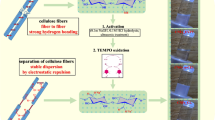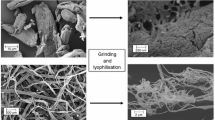Abstract
Carboxylated cellulose nanofibers were extracted from different biological species, including cotton, spruce wood, bamboo and bacterial cellulose, through a combined (2,2,6,6-tetramethyl- piperidine-1-yl)oxyl (TEMPO)-mediated oxidation and mechanical defibrillation treatment. The cross-section dimensions of isolated cellulose nanofibers in suspension were characterized by small-angle X-ray scattering, where the results were in agreement with the transmission electron microscopy measurement. For the spruce wood samples, the effects of three experimental variables in the combined TEMPO-oxidation and mechanical treatment on the dimensions and degree of oxidation of the resulting cellulose nanofibers were quantitatively investigated.




Similar content being viewed by others
References
Allaire M, Yang L (2011) Biomolecular solution X-ray scattering at the National Synchrotron Light Source. J Synchrotron Radiat 18:41–44. doi:10.1107/S0909049510036022
Araki J, Wada M, Kuga S (2001) Steric stabilization of a cellulose microcrystal suspension by poly(ethylene glycol) grafting. Langmuir 17:21–27. doi:10.1021/La001070m
Azeredo HMC, Mattoso LHC, Avena-Bustillos RJ, Ceotto G, Munford ML, Wood D, McHugh TH (2010) Nanocellulose reinforced chitosan composite films as affected by nanofiller loading and plasticizer content. J Food Sci 75:N1–N7. doi:10.1111/J.1750-3841.2009.01386.X
Beck-Candanedo S, Roman M, Gray DG (2005) Effect of reaction conditions on the properties and behavior of wood cellulose nanocrystal suspensions. Biomacromolecules 6:1048–1054. doi:10.1021/Bm049300p
Bondeson D, Mathew A, Oksman K (2006) Optimization of the isolation of nanocrystals from microcrystalline cellulose by acid hydrolysis. Cellulose 13:171–180. doi:10.1007/S10570-006-9061-4
Braun B, Dorgan JR, Chandler JP (2008) Cellulosic nanowhiskers. Theory and application of light scattering from polydisperse spheroids in the Rayleigh–Gans–Debye regime. Biomacromolecules 9:1255–1263. doi:10.1021/Bm7013137
Campbell NA (1996) Biology, 4th edn. Benjamin Cummings, NY
Dong XM, Revol JF, Gray DG (1998) Effect of microcrystallite preparation conditions on the formation of colloid crystals of cellulose. Cellulose 5:19–32. doi:10.1023/A:1009260511939
Eichhorn SJ et al (2010) Review: current international research into cellulose nanofibres and nanocomposites. J Mater Sci 45:1–33. doi:10.1007/S10853-009-3874-0
Elazzouzi-Hafraoui S, Nishiyama Y, Putaux JL, Heux L, Dubreuil F, Rochas C (2008) The shape and size distribution of crystalline nanoparticles prepared by acid hydrolysis of native cellulose. Biomacromolecules 9:57–65. doi:10.1021/bm700769p
Fukuzumi H, Saito T, Wata T, Kumamoto Y, Isogai A (2009) Transparent and high gas barrier films of cellulose nanofibers prepared by TEMPO-mediated oxidation. Biomacromolecules 10:162–165. doi:10.1021/Bm801065u
Grunert M, Winter WT (2002) Nanocomposites of cellulose acetate butyrate reinforced with cellulose nanocrystals. J Polym Environ 10:27–30. doi:10.1023/A:1021065905986
Habibi Y, Chanzy H, Vignon MR (2006) TEMPO-mediated surface oxidation of cellulose whiskers Cellulose 13:679–687. doi:10.1007/S10570-006-9075-Y
Habibi Y, Goffin AL, Schiltz N, Duquesne E, Dubois P, Dufresne A (2008) Bionanocomposites based on poly(epsilon-caprolactone)-grafted cellulose nanocrystals by ring-opening polymerization. J Mater Chem 18:5002–5010. doi:10.1039/B809212e
Habibi Y, Mahrouz M, Vignon MR (2009) Microfibrillated cellulose from the peel of prickly pear fruits. Food Chem 115(423–429):2008. doi:10.1016/J.Foodchem.12.034
Habibi Y, Lucia LA, Rojas OJ (2010) Cellulose nanocrystals: chemistry, self-assembly, and applications. Chem Rev 110:3479–3500. doi:10.1021/Cr900339w
Iwamoto S, Nakagaito AN, Yano H (2007) Nano-fibrillation of pulp fibers for the processing of transparent nanocomposites. Appl Phys Mater 89:461–466. doi:10.1007/S00339-007-4175-6
Khan RA, Salmieri S, Dussault D, Uribe-Calderon J, Kamal MR, Safrany A, Lacroix M (2010) Production and properties of nanocellulose-reinforced methylcellulose-based biodegradable films. J Agric Food Chem 58:7878–7885. doi:10.1021/Jf1006853
Klemm D, Heublein B, Fink HP, Bohn A (2005) Cellulose: fascinating biopolymer and sustainable raw material. Angew Chem Int Edit 44:3358–3393. doi:10.1002/Anie.200460587
Leitner J, Hinterstoisser B, Wastyn M, Keckes J, Gindl W (2007) Sugar beet cellulose nanofibril-reinforced composites. Cellulose 14:419–425. doi:10.1007/S10570-007-9131-2
Ma HY, Burger C, Hsiao BS, Chu B (2011) Ultrafine polysaccharide nanofibrous membranes for water purification. Biomacromolecules 12:970–976. doi:10.1021/Bm1013316
Ma HY, Buger C, Hsiao BS, Chu B (2014) Fabrication and characterization of cellulose nanofiber based thin-film nanofibrous composite membranes. J Membr Sci 454:272–282. doi:10.1016/j.memsci.2013.11.055
Malainine ME, Mahrouz M, Dufresne A (2005) Thermoplastic nanocomposites based on cellulose microfibrils from Opuntia ficus-indica parenchyma cell. Compos Sci Technol 65(1520–1526):2005. doi:10.1016/J.Compscitech.01.003
Montanari S, Rountani M, Heux L, Vignon MR (2005) Topochemistry of carboxylated cellulose nanocrystals resulting from TEMPO-mediated oxidation. Macromolecules 38:1665–1671. doi:10.1021/Ma048396c
Paakko M et al (2007) Enzymatic hydrolysis combined with mechanical shearing and high-pressure homogenization for nanoscale cellulose fibrils and strong gels. Biomacromolecules 8:1934–1941. doi:10.1021/Bm061215p
Pandey JK, Lee JW, Chu WS, Kim CS, Ahn SH (2008) Cellulose nano whiskers from grass of Korea. Macromol Res 16:396–398
Saito T, Nishiyama Y, Putaux JL, Vignon M, Isogai A (2006) Homogeneous suspensions of individualized microfibrils from TEMPO-catalyzed oxidation of native cellulose. Biomacromolecules 7:1687–1691. doi:10.1021/Bm060154s
Saito T, Kimura S, Nishiyama Y, Isogai A (2007) Cellulose nanofibers prepared by TEMPO-mediated oxidation of native cellulose. Biomacromolecules 8:2485–2491. doi:10.1021/Bm0703970
Saito T, Hirota M, Tamura N, Kimura S, Fukuzumi H, Heux L, Isogai A (2009) Individualization of nano-sized plant cellulose fibrils by direct surface carboxylation using TEMPO catalyst under neutral conditions. Biomacromolecules 10:1992–1996. doi:10.1021/Bm900414t
Saito T, Kuramae R, Wohlert J, Berglund LA, Isogai A (2013) An ultrastrong nanofibrillar biomaterial: the strength of single cellulose nanofibrils revealed via sonication-induced fragmentation. Biomacromolecules 14:248–253. doi:10.1021/Bm301674e
Samir MASA, Alloin F, Dufresne A (2005) Review of recent research into cellulosic whiskers, their properties and their application in nanocomposite field. Biomacromolecules 6:612–626. doi:10.1021/Bm0493685
Siro I, Plackett D (2010) Microfibrillated cellulose and new nanocomposite materials: a review. Cellulose 17:459–494. doi:10.1007/S10570-010-9405-Y
Su Y, Burger C, Hsiao BS, Chu B (2014) Characterization of TEMPO-oxidized cellulose nanofibers in aqueous suspension by small-angle X-ray scattering. J Appl Crystallogr 47:788–798. doi:10.1107/S1600576714005020
Su Y, Burger C, Ma H, Chu B, Hsiao BS (2015) Exploring the nature of cellulose microfibrils Biomacromolecules 16:1201–1209. doi:10.1021/bm501897z
Taniguchi T, Okamura K (1998) New films produced from microfibrillated natural fibres. Polym Int 47:291–294. doi:10.1002/(Sici)1097-0126(199811)47:3<291:Aid-Pi11>3.0.Co;2-1
van den Berg O, Capadona JR, Weder C (2007) Preparation of homogeneous dispersions of tunicate cellulose whiskers in organic solvents. Biomacromolecules 8:1353–1357. doi:10.1021/Bm061104q
Wang B, Sain M (2007) Isolation of nanofibers from soybean source and their reinforcing capability on synthetic polymers. Compos Sci Technol 67(2521–2527):2006. doi:10.1016/J.Compscitech.12.015
Xu XZ, Wang HR, Jiang L, Wang XN, Payne SA, Zhu JY, Li RP (2014) Comparison between cellulose nanocrystal and cellulose nanofibril reinforced poly(ethylene oxide) nanofibers and their novel shish-kebab-like crystalline structures. Macromolecules 47:3409–3416. doi:10.1021/Ma402627j
Yang QL, Wu CN, Saito T, Isogai A (2014) Cellulose-clay layered nanocomposite films fabricated from aqueous cellulose/LiOH/urea solution. Carbohyd Polym 100(179–184):2012. doi:10.1016/J.Carbpol.10.044
Acknowledgments
The financial support for this work was provided by the SusChEM program of the National Science Foundation (DMR-1409507). The authors thank the NSLS and the CFN at BNL for granting access to the synchrotron beam and TEM facilities. We thank Drs. Lin Yang and Vito Graziano for their assistance at Beamline X9, and Mr. Kim Kisslinger at CFN for his assistance with the TEM observations. We are also grateful to Mr. Wen-Hung (Chester) Chang from the Hainan NAYA company for providing bacterial cellulose samples and Dr. Tong Wang of the Biology Department at BNL for assisting the TEM sample preparation.
Author information
Authors and Affiliations
Corresponding authors
Ethics declarations
Conflict of interest
The authors declare that they have no conflict of interest.
Rights and permissions
About this article
Cite this article
Su, Y., Burger, C., Ma, H. et al. Morphological and property investigations of carboxylated cellulose nanofibers extracted from different biological species. Cellulose 22, 3127–3135 (2015). https://doi.org/10.1007/s10570-015-0698-8
Received:
Accepted:
Published:
Issue Date:
DOI: https://doi.org/10.1007/s10570-015-0698-8




